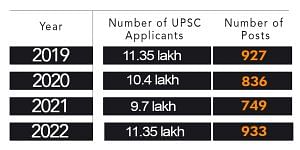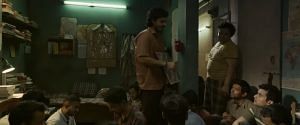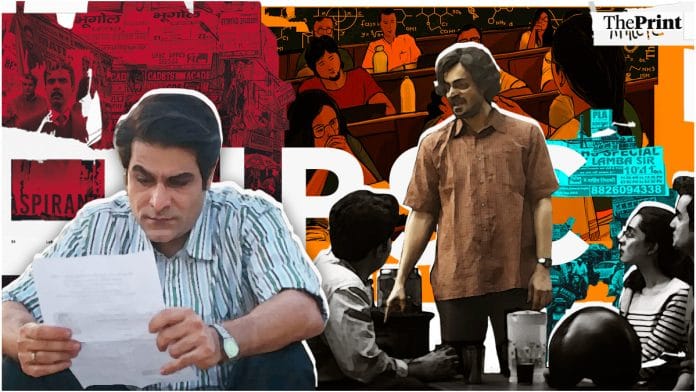New Delhi: Namit Kumar found his ‘bhaiya’ in the narrow streets of the UPSC coaching hub that is Delhi’s Mukherjee Nagar. The 24-year-old was weaving his way through stationery stores, booksellers, coaching class hoardings, and past the momo and gol gappa vendors to stop at a chai stall when he met Gopal Jha, 29. Everyone in the area knows Jha. He’s a UPSC ‘veteran’— having attempted the competitive civil services examination six times, and even reaching the interview level once. But with no more chances, and no clear idea of what he will do next, he has become a mentor and ‘big brother’ to new aspirants like Kumar.
Jha and others like him, who gave the best years of their youth to UPSC preparations, are Mukherjee Nagar’s Sandeep ‘bhaiyas’—the popular character from TVF’s hit show Aspirants, who now has his very own spin-off. Vidhu Vinod Chopra’s 12th Fail also taps into this trend through ‘Gauri bhaiya’, who couldn’t clear the exam himself but helped others get past the hurdle.
“Bhaiya, I am finding it difficult to complete the answer writing on time, I think I have to do something about my time management,” says Kumar, who left his home in Kasganj, Uttar Pradesh, for Delhi with stars in his eyes and dreams of becoming an IAS officer. As the two bond over a cup of tea, Jha patiently answers Kumar’s questions.

“Give each question a specific time and write fast. Answer questions that you know first,” he says, putting a comforting arm over Kumar’s shoulder. The conversation drifts to memes, current affairs, and cinema. Kumar meets Jha every alternate day for advice and some pep talk.
Shows like Aspirants have mainstreamed the bhaiya culture, but it’s been a part of the UPSC coaching ecosystem for years. The bhaiyas are almost always young men who simply don’t know how to disengage from the UPSC preparation cycle. They’ve spent lakhs on coaching classes, every minute studying for one of the most difficult entrance exams in the world, picked up the pieces when they didn’t make the cut, and did it again—and again. Now, they bask in the respect of almost having made it and are treated like knowledgeable ‘elders’ by every new batch of aspirants hoping to enter the civil services.
“Bhaiya or baba culture began in university hostels and rented housing. Though it looks like mentoring, it’s actually an expression of the power structure [within these settings],” says Vijender Chauhan, educator and UPSC mock interviewer.
The number of years a bhaiyaspends preparing for prelims/mains and the number of times they’ve cleared these exams to reach the interview stage determines the extent of their “power and influence”.

“The anxiety and insecurity of fresh aspirants fuel this power system,” says Chauhan.
Also read: UPSC toppers are a catch for all. And coaching centres want their photos, consent be damned
Advice, tips, speeches
Shantanu Yadav, now 33, was part of this culture for nearly 10 years, having arrived at Mukherjee Nagar when he was barely 24. By the sixth year, he was a ‘senior bhaiya’ ready to dole out advice, tips and motivational speeches. For years, he couldn’t think of doing anything else.
“The social recognition and influence [older aspirants wield] keep students glued to this environment when they should have moved on to Plan B after one or two attempts,” adds Chauhan.

Marriage–at his parent’s insistence–wrenched Yadav out of Mukherjee Nagar back to his home in Meerut where he teaches UPSC aspirants at a coaching centre. But he has fond memories of his time in Delhi; it was a coming-of-age rite of passage for him.
Many aspirants at Mukherjee Nagar, and even those who cleared the examination still talk of ‘Shantanu bhaiya’ who sat for the mains six times and reached the interview level twice.
“When Shantanu bhaiya shared his UPSC failure experience, it was more than just recounting setbacks. It was a candid revelation of the emotional and intellectual toll of the journey,” said Utkarh Narayan, who cleared UPSC two years ago and is currently working at the Indian Railways. What resonated with him was Yadav’s advice on facing disappointments, handling self-doubt, and learning from mistakes.
“His recounting of his struggles served as a reality check for me,” adds Narayan, who still keeps in touch with Yadav.
Such advice, he insists, is important in a culture that only celebrates success. Coaching institutes put up hoardings of toppers who are treated like conquering heroines on social media. But everyone is silent on the lakhs of aspirants who are weeded out of the selection process every year. Only a minuscule fraction get to join the civil services.

Around 11 lakh aspirants reportedly applied for the UPSC exam in 2022, of which only 933 were recommended by the commission for appointment to various services. In 2019, more than 11.35 lakh students applied for the prelims – 11,845 of these appeared for the mains, 2,306 made it to the interview round, and ultimately, only 927 became part of the bureaucracy. That figure came down to 836 civil servants in 2020 and dropped to 749 in 2021.
Yadav doesn’t see this as a power equation, but more as a way of helping aspirants navigate a new world. Thousands of candidates arrive at Mukherjee and Rajinder Nagar every year, and Shantanu bhaiya made sure to guide some of them.
“Some are scared in the beginning. They ask a lot of questions about UPSC syllabus, time management, coaching, optional subjects etc,” says Yadav, who usually opens such conversations with generic advice.
“In the first interaction, I tell them that UPSC is not the end of the world and ask them to check their capabilities. However, that changes as he gets to know his ‘mentees’, and what part of the preparation they are struggling with.
Tej Pratap Singh (29) does not wield the same clout as Yadav or Kumar but has become a near-permanent fixture at Mukherjee Nagar since he stepped into the world in 2019 after getting his LLB from Delhi University. Five years later, new aspirants have now started approaching him for guidance.
“Sometimes they ask funny questions like – ‘Bhaiya, will I get the posting in my own district?’ or ‘Bhaiya, do IAS officers get 6 cars?’, recalls Singh with a grin.
Mukherjee Nagar is home for Singh, who sustains on pocket money from his family and only returns to his hometown in UP’s Mainpuri for Holi and Diwali. While cracking UPSC is his life’s goal, he firmly believes in having a Plan B.
“Naukri aur Naukarshahi me farq hai [There is a difference between a regular job and a bureaucratic one]. But if I have to do something else, I will go for litigation as I am a law graduate,” he says.
Also read:
Becoming bhaiya
Staying power alone, however, does not determine who commands the respect given to bhaiyas. The number of times an aspirant has cleared the mains, and the number of interview rounds they’ve been through all count in this structured microcosm. Becoming bhaiya isn’t child’s play.
“I missed the final list by three marks one time, which everyone got to know about. Young aspirants started coming to me for guidance soon after,” recalls Yadav.
Candidates would gather around him whenever he stopped for tea, and would sometimes knock on his door to discuss their problems.
Senior aspirants go out of their way to cultivate the big brother relationship with their juniors. It allows them to briefly forget that they are running out of time.
“I have guided people for their mains, optional subjects and for their interview too. One aspirant asked me to take a practice interview with him. He got selected two years ago,” adds Yadav. That further cemented his status as a bhaiya.
The selection of their ‘proteges’ is a proud moment for bhaiyas, a feather in their caps.

In 12th Fail, Gauri Bhaiya’s character tells a young aspirant: “I may not have been selected, but if you do with my assistance, I will consider it my victory, my selection.”
Yadav still has some hope left. As an OBC candidate, he can take the UPSC exam nine times until the age of 35. And he’s got two more attempts. General category aspirants can sit for the entrance exam six times till the age of 32.
“My younger brother asks me what I did all those years – a question I ask myself too,” Yadav tells ThePrint over the phone.
Also read: Khan sir, Ojha sir, Study IQ to NEXT IAS—an aggressive UPSC coaching market war is on
Never going back home
Mohit Pandey (30), a ‘senior bhaiya’ from Rajinder Nagar, has exhausted all his chances but refuses to go back home to Lucknow. People in his Lucknow neighbourhood say this is precisely why parents should think twice before sending their children to other cities.
“They say things like, ‘He went to Delhi to become a collector, see what he has done with his life now.’ I don’t go home much because I don’t have any good news for my parents, and a lot of taunts wait for me there,” he says.
However, he cheers up when talking about the space he’s carved for himself in Delhi after eight attempts at UPSC.
“I was a young aspirant at one point. I understand the anxiety, excitement and fear these candidates experience,” says Pandey. Talking to him gives students a glimpse into the cut-throat world of UPSC preparation.
Pandey’s day starts at 5 AM with a morning walk where he meets aspirants to discuss world politics and foreign affairs. From there he heads to his part-time job at a local library. In between, he evaluates mock tests for some coaching institutes, receiving payment for each copy he checks.
He has spent far too many years on his own. There’s no question of seeking financial help from home.
“People like me know that this place has nothing for us anymore. But breathing in the same air makes us feel like our dream is still alive,” says Pandey, while sipping hot tea and watching young aspirants from a distance.
(Edited by Zoya Bhatti)






